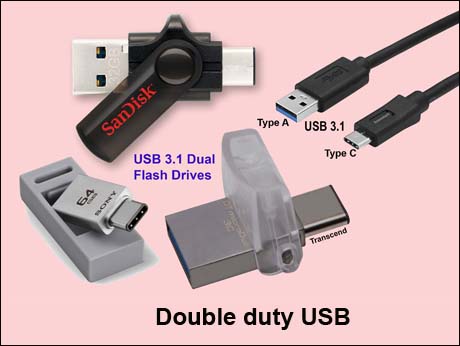
After 20 years, the USB connector is up for a major upgrade. Here's what you need, to tide over the transition
By Anand Parthasarathy
Bangalore, June 12 2016: Older reader will remember the big, fat, desktop PCs of the 1990s -- with their bulky dabbas and a fat CRT monitor , taking away most of the space on your desk. Perhaps, the most vivid memory is of that cat's cradle of wires on the back of the machine -- a rear wall pockmarked like ageing cheese, with multiple holes for a serial port, a printer port, a keyboard port and a PS/2 port for the mouse, plus those tiny coloured holes in which to stick the loudspeaker and mike connector.
Checked any PCs lately? Chances are you'll find 4 to 6 identical USB ports which work with almost every accessory device. Plug-n-play is the new way with PC accessories. The Universal Serial Bus or USB is actually just over 20 years old -- but it is only in recent years that it has emerged as the undisputed king of the connector jungle, in the process, having gone through a few upward bumps in the speed at which it can transfer data. The current USB 3.1 standard, is the zippiest, to date, transferring data at a typical 150 - 200 MBPS which is about 10 times faster than what we could achieve with USB 2.
While USB reading speeds have been jacked up, the physical connector has remained largely unchanged, until recently. The familiar USB Type A connector has one big hassle: it goes in only one way -- and it seems, we always insert it the wrong way, the first time!
The new Type C USB connector overcomes this pain point: it is reversible, ie, you can insert it into a USB socket, any way you like. You will increasingly find, that newer devices like notebooks, tablets, printers, music players or speakers come with the new Type C port. In fact its smaller sized has allowed phone makers to replace the micro version of the USB Type A connector even on phones, with the Type C. And this immediately poses a problem.
Almost all the things we connect into our smart phones -- battery chargers, memory sticks, external speakers -- currently sport a micro USB A connection. For some time to come, we need to carry an extra adaptor cable that lets you use your Type C phone or device with a Type A accessory.
This has one downside: You may overcome the physical problem, but you will lose out on the higher speed and considerable versatility of your Type C device. Just think: The single Type C port in your new phone or tablet is a sort of agni astra: Industry is all set to ditch the 3.5 mm audio jack and let the USB port on your phone do double duty: charging devices and providing an audio path. The Chinese company LeEco, recently launched a couple of phones -- Le 2 and LeMax 2 -- where they have done away with the audio jack completely: the Type C audio jack does the job and if required also charges the phone. The phones are coming to India starting June 28 -- and we will bring you our detailed review in this space very soon. We can however provide a sneak preview of an unexpected bonus that comes when a Type C USB is used to make an audio connection: Since any USB connection carries 5 volts DC, headphone makers have been able to throw away the heavy batteries they used to put in to drive the noise cancelling circuits -- and simply use the current that is available to all takers on the USB connection.
The Type C also handles more power up to 20 volts and 5 amperes ( or 100 watts). This means it can be used to charge almost all devices -- even a laptop typically needs only 60 watts.
Such are some of the benefits of the industry's lurch to a new USB standard.
To tide over the transition, makers of USB flash drives have just launched some dual drive models-- with a Type C connector at one end and a Type A at the other:
A simple USB Type C-to-Type A convertor with no onboard storage can be bought online for a couple of hundred rupees.
Armed with such a cable, plus a double ended Flash drive like the ones described, you can have a relatively hassle free time, as you say: 'Goodbye Type A, hello Type C', in the Brave New World of the USB connector.